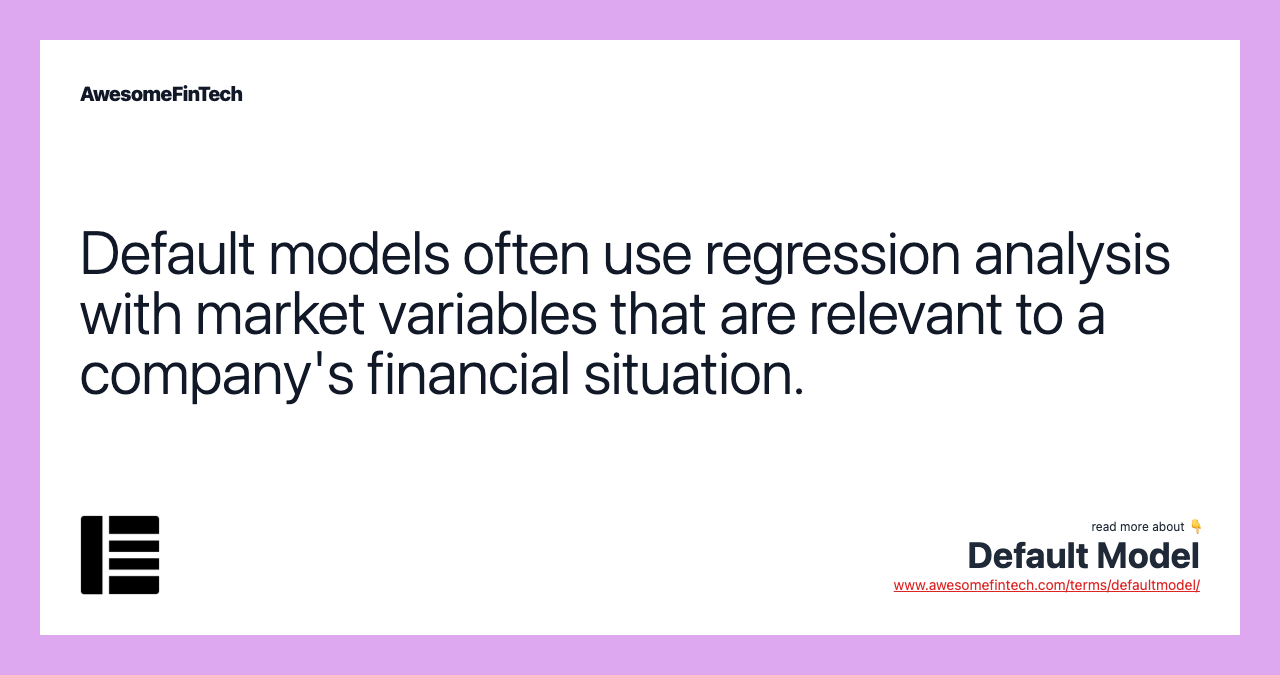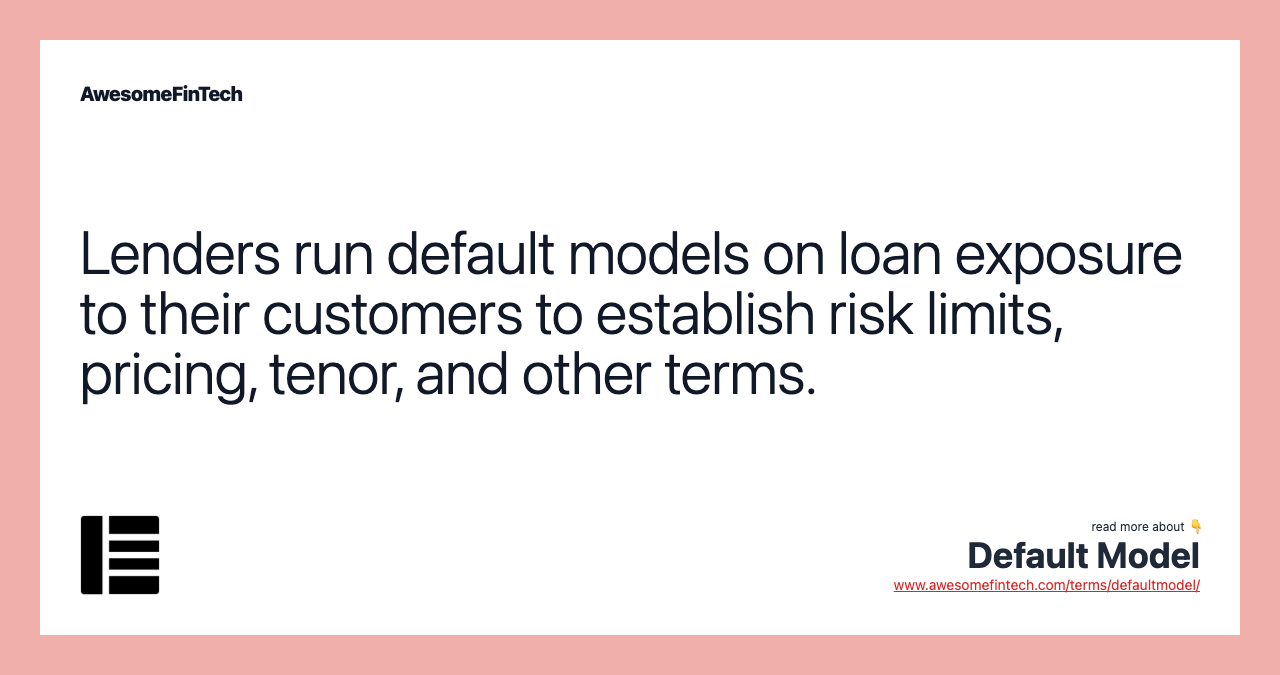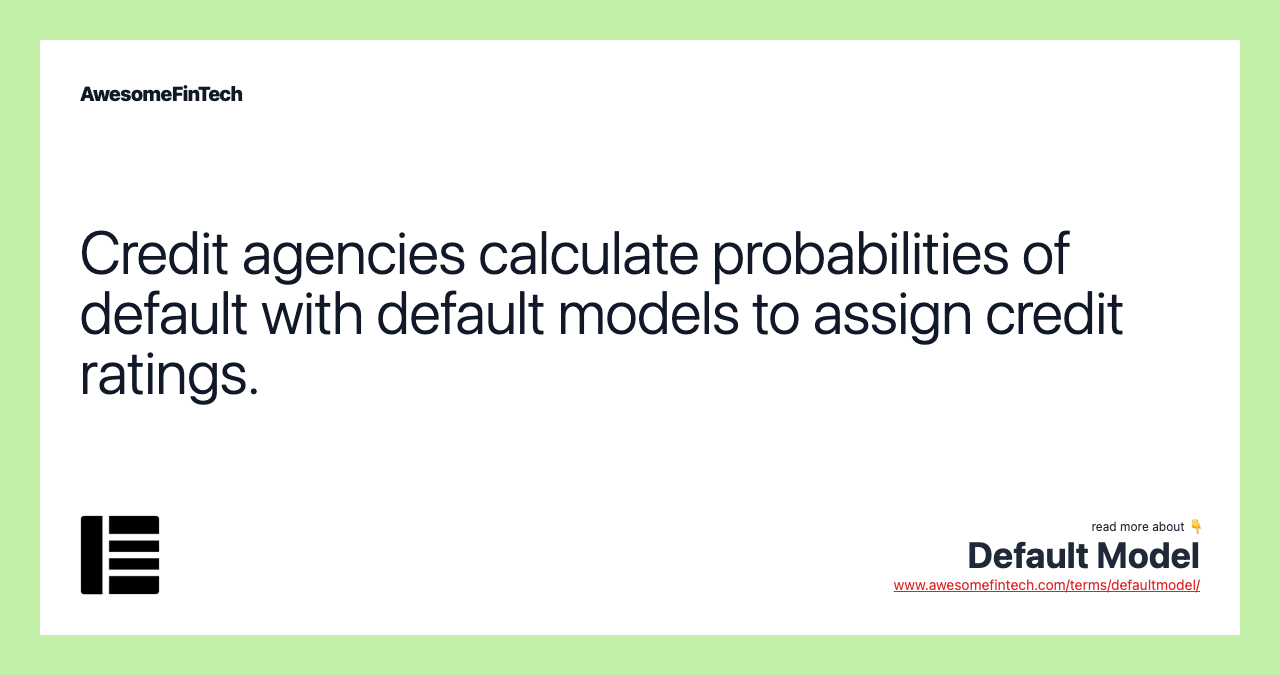Default Model
A default model is constructed by financial institutions (FIs) to determine the likelihood of a default on credit obligations by a corporation or sovereign entity. Before a bank or other lending institution extends substantial credit to a customer, it will set up a default model, running all the relevant numbers to calculate potential loss exposure. The relationships between dependent and independent variables will be established, and with the input of varying sets of assumptions into the model, an output of default probabilities (under sensitivity analysis) will be produced. A default model is essential for a standard loan, but it is also critical in quantifying risk for more sophisticated products such as credit default swaps (CDSs). One of the first reduced-form models was the Jarrow Turnbull model, which utilizes multi-factor and dynamic analysis of interest rates to calculate the probability of default. Most banks and credit rating agencies use a combination of structural and reduced-form models, as well as proprietary variants, to assess credit risk. Credit agencies calculate probabilities of default with default models to assign credit ratings. A default model is constructed by financial institutions to determine default probabilities on credit obligations by a corporation or sovereign entity.

What Is a Default Model?
A default model is constructed by financial institutions (FIs) to determine the likelihood of a default on credit obligations by a corporation or sovereign entity. These statistical models often use regression analysis with certain market variables that are pertinent to a company's financial situation to identify the nature and scope of credit risk.
Internally, a lender runs default models on loan exposure to their customers to determine risk limits, pricing, tenor, and other terms. Credit agencies, meanwhile, calculate probabilities of default with the models in order to assign credit ratings.




Understanding Default Models
Before a bank or other lending institution extends substantial credit to a customer, it will set up a default model, running all the relevant numbers to calculate potential loss exposure. The relationships between dependent and independent variables will be established, and with the input of varying sets of assumptions into the model, an output of default probabilities (under sensitivity analysis) will be produced.
A default model is essential for a standard loan, but it is also critical in quantifying risk for more sophisticated products such as credit default swaps (CDSs). For a CDS, a financial derivative or contract that allows an investor to "swap" or offset their credit risk with that of another investor, the buyer and seller would run their own default models on an underlying credit to determine the terms of the transaction.
The bread-and-butter business of credit agencies such as Moody's and Standard & Poor's is developing sophisticated default models. The goal of these models is to designate credit ratings that are standard in most cases for bond (or other credit-linked product) issuance into the public markets.
The entities for which a default model is established can be corporations, municipalities, countries, government agencies, and special purpose vehicles. In all cases, the model will estimate the probabilities of default under various scenarios. Generally, the higher the default probability, the higher the interest rate the lender will charge the borrower.
Types of Default Models
There exist two different schools of thought on how best to measure credit risk that influence the manner in which default models are pieced together. They are:
Structural Models
Structural models assume complete knowledge of a company’s assets and liabilities, resulting in a predictable default time. Often called Merton models, after the Nobel laureate academic Robert C. Merton, these models conclude that default risks occur at the maturing date if, at that stage, the value of a company’s assets fall below its outstanding debt.
Reduced-Form Models
Reduced-form models, on the other hand, take the view that the modeler is in the dark about the company's financial condition. Defaulting is treated as an unexpected event that can be governed by a multitude of different factors going on in the market.
One of the first reduced-form models was the Jarrow Turnbull model, which utilizes multi-factor and dynamic analysis of interest rates to calculate the probability of default.
Important
Most banks and credit rating agencies use a combination of structural and reduced-form models, as well as proprietary variants, to assess credit risk.
Criticism of Default Models
Default models are by no means flawless and have attracted plenty of controversy over the years. One big example is the 2008 financial crisis.
Credit agencies were blamed for being partly responsible for the great recession of the late 2000s because they gave triple-A ratings to hundreds of billions of dollars worth of collateralized debt obligations (CDO) packed with subprime loans.
With the stamp of approval of high credit ratings, CDOs were prostituted out around the markets by Wall Street. What happened to those CDOs is well known. One can only hope that credit agencies have made the necessary adjustments to their default models to avoid future mishaps.
Related terms:
Accounting
Accounting is the process of recording, summarizing, analyzing, and reporting financial transactions of a business to oversight agencies, regulators, and the IRS. read more
Asset
An asset is a resource with economic value that an individual or corporation owns or controls with the expectation that it will provide a future benefit. read more
Bond : Understanding What a Bond Is
A bond is a fixed income investment in which an investor loans money to an entity (corporate or governmental) that borrows the funds for a defined period of time at a fixed interest rate. read more
Collateralized Debt Obligation (CDO)
A collateralized debt obligation (CDO) is a complex financial product backed by a pool of loans and other assets and sold to institutional investors. read more
Credit Agency
Credit agencies gather debt information that is used to generate a score that indicates creditworthiness. read more
Credit Default Insurance
Credit default insurance is a financial agreement to mitigate the risk of loss from default by a borrower or bond issuer. read more
Credit Scoring
Credit scoring generates a score that ranks, on a numerical scale, the credit riskiness of an individual or a small, owner-operated business. read more
Credit Default Swap (CDS) & Example
A credit default swap (CDS) is a particular type of swap designed to transfer the credit exposure of fixed income products between two or more parties. read more
Credit Rating
A credit rating is an assessment of the creditworthiness of a borrower—in general terms or with respect to a particular debt or financial obligation. read more
Credit Risk
Credit risk is the possibility of loss due to a borrower's defaulting on a loan or not meeting contractual obligations. read more